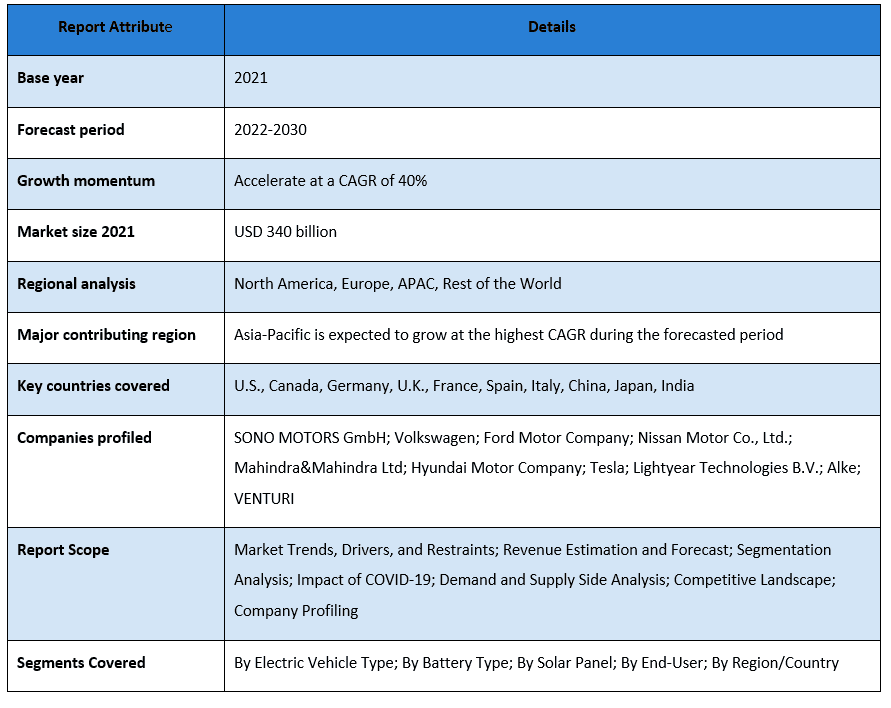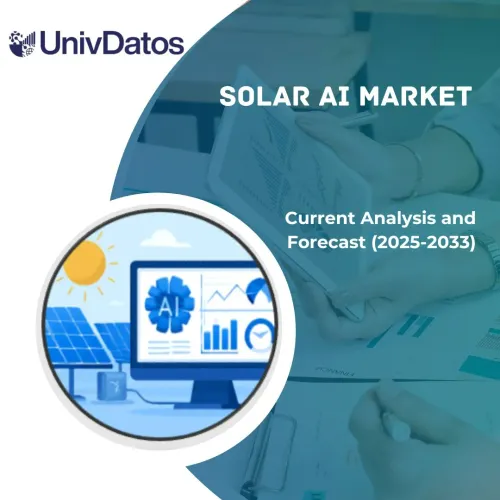- Home
- About Us
- Industry
- Services
- Reading
- Contact Us
Solar Vehicle Market: Current Analysis and Forecast (2023-2030)
Emphasis on Electric Vehicle Type (Battery Electric Vehicle (BEV), Hybrid Electric Vehicle (HEV), and Plug-in Hybrid Electric Vehicle (PHEV)); Battery Type (Lithium Ion, Lead Acid, and Lead Carbon); Solar Panel (Monocrystalline and Polycrystalline); End-User (Passenger Vehicle and Commercial Vehicle); and Region/Country

Global Solar Vehicle Market is expected to grow at a strong CAGR of around 40% during the forecast period. A solar vehicle is defined as an electric vehicle powered completely or significantly by direct solar energy. Usually, photovoltaic (PV) cells contained in solar panels convert the sun’s energy directly into electric energy. The term “solar vehicle” usually implies that solar energy is used to power all or part of a vehicle’s propulsion. Solar power may also be used to provide power for communications or controls or other auxiliary functions. Many players in the market are launching new products with technologically advanced features. For instance, in Nov 2022, Munich-based Sono Motors launched a Sion solar electric car in Finland. Also, in Jun 2022, Lightyear launched its world’s first solar car with a 1000 km range by the end of 2022. Factors such as the increasing adoption of the latest technology for vehicles coupled with the growing demand for energy-efficient sources and alternatives to fuel. For instance, in Aug 2019, Hyundai launched its first car with a solar roof charging system to improve fuel efficiency while preventing battery discharge and reducing CO2 emissions. Also, For instance, in Aug 2022, Ford secured 650 megawatts of solar energy for carbon-free vehicle production in Michigan to reduce carbon neutrality.
SONO MOTORS GmbH; Volkswagen; Ford Motor Company; Nissan Motor Co., Ltd.; Mahindra&Mahindra Ltd; Hyundai Motor Company; Tesla; Lightyear Technologies B.V.; Alke; VENTURI are some of the key players in the market. Several M&As along with partnerships have been undertaken by these players to facilitate customers with hi-tech and innovative products/technologies.
Insights Presented in the Report
“Based on solar panel, monocrystalline category is expected to grow with a significant CAGR during the forecast period”
Based on solar panel, the solar vehicle market has been classified into monocrystalline and polycrystalline. The monocrystalline category is expected to grow with a significant CAGR during the forecast period. This is mainly due to the factors that they are highly efficient and durable which makes them an attractive choice. Monocrystalline solar panels have higher energy efficiency so that they can produce more electricity from the same amount of sunlight. Furthermore, to meet the requirements of vehicles that need a durable and continuous source of energy, monocrystalline panels have an extra period of life that’s greater than what is possible with all types of solar panels. Thus, such factors are expected to increase the demand for Monocrystalline solar vehicle in the market.
“Amongst end-user, passenger vehicle are expected to grow with a significant CAGR during the forecast period”
On the basis of end-user, the market is categorized into passenger vehicle and commercial vehicle. Among these, the passenger vehicles are expected to grow with a significant CAGR during the forecast period. To help improve the quality and range of Solar Passenger Vehicles, companies are looking at developing more effective panels and energy storage systems. In addition, there is growing demand from consumers for eco-friendly vehicles that could trigger a boom in solar power cars in passenger vehicles.
Solar vehicle Market Report Coverage

“APAC is anticipated to grow at a substantial CAGR during the forecast period”
In 2021, APAC is anticipated to grow at a substantial CAGR during the forecast period. This is mainly due to the increasing concerns about air pollution, the need to reduce greenhouse gas emissions, and government initiatives to promote the use of electric and solar-powered vehicles in the region. The government of China has implemented several policies and initiatives to support the use of electric and solar-powered vehicles, including subsidies and tax incentives for manufacturers and consumers. This has led to a significant rise in the production and adoption of electric and solar vehicles in China. Other countries in the region, such as Japan, South Korea, and India, are expected to witness growth in this market in the forecasted years. These countries have also implemented policies and initiatives to promote the use of electric and solar-powered vehicles and there is growing interest among consumers in adopting these technologies. For instance, in Feb 2023, Pune startup to launch India’s first solar electric car Eva in 2024. The car is designed to accommodate two adults and a child; contains 150-watt solar panels on the sunroof that can give it 10-12 km of range every day. It can be charged in four hours at home with a regular house socket and with a DC fast-charging option, it reaches 80 percent charge in 45 minutes.
Reasons to buy this report:
- The study includes market sizing and forecasting analysis validated by authenticated key industry experts.
- The report presents a quick review of overall industry performance at one glance.
- The report covers an in-depth analysis of prominent industry peers with a primary focus on key business financials, product portfolios, expansion strategies, and recent developments.
- Detailed examination of drivers, restraints, key trends, and opportunities prevailing in the industry.
- The study comprehensively covers the market across different segments.
- Deep dive regional level analysis of the industry.
Customization Options:
The global solar vehicle market can further be customized as per the requirement or any other market segment. Besides this, UMI understands that you may have your own business needs, hence feel free to connect with us to get a report that completely suits your requirements.
Table of Content
Research Methodology for the Solar Vehicle Market Analysis (2023-2030)
Analyzing the historical market, estimating the current market, and forecasting the future market of the global solar vehicle market were the three major steps undertaken to create and analyze the adoption of solar vehicle in major regions globally. Exhaustive secondary research was conducted to collect the historical market numbers and estimate the current market size. Secondly, to validate these insights, numerous findings and assumptions were taken into consideration. Moreover, exhaustive primary interviews were also conducted, with industry experts across the value chain of the global solar vehicle market. Post assumption and validation of market numbers through primary interviews, we employed a top-down/bottom-up approach to forecasting the complete market size. Thereafter, market breakdown and data triangulation methods were adopted to estimate and analyze the market size of segments and sub-segments of the industry pertains to. Detailed methodology is explained below:
Analysis of Historical Market Size
Step 1: In-Depth Study of Secondary Sources:
Detail secondary study was conducted to obtain the historical market size of the solar vehicle market through company internal sources such as annual reports & financial statements, performance presentations, press releases, etc., and external sources including journals, news & articles, government publications, competitor publications, sector reports, third-party database, and other credible publications.
Step 2: Market Segmentation:
After obtaining the historical market size of the solar vehicle market, we conducted a detailed secondary analysis to gather historical market insights and share for different segments & sub-segments for major regions. Major segments are included in the report as electric vehicle type, battery type, solar panel, and end-user. Further country-level analyses were conducted to evaluate the overall adoption of testing models in that region.
Step 3: Factor Analysis:
After acquiring the historical market size of different segments and sub-segments, we conducted a detailed factor analysis to estimate the current market size of the solar vehicle market. Further, we conducted factor analysis using dependent and independent variables such as various electric vehicle type, battery type, solar panel, and end-user of solar vehicle. A thorough analysis was conducted for demand and supply-side scenarios considering top partnerships, mergers and acquisitions, business expansion, and product launches in the solar vehicle market sector across the globe.
Current Market Size Estimate & Forecast
Current Market Sizing: Based on actionable insights from the above 3 steps, we arrived at the current market size, key players in the global solar vehicle market, and market shares of the segments. All the required percentage shares split, and market breakdowns were determined using the above-mentioned secondary approach and were verified through primary interviews.
Estimation & Forecasting: For market estimation and forecast, weights were assigned to different factors including drivers & trends, restraints, and opportunities available for the stakeholders. After analyzing these factors, relevant forecasting techniques i.e., the top-down/bottom-up approach were applied to arrive at the market forecast for 2030 for different segments and sub-segments across the major markets globally. The research methodology adopted to estimate the market size encompasses:
- The industry’s market size, in terms of revenue (USD) and the adoption rate of the solar vehicle market across the major markets domestically
- All percentage shares, splits, and breakdowns of market segments and sub-segments
- Key players in the global solar vehicle market in terms of products offered. Also, the growth strategies adopted by these players to compete in the fast-growing market
Market Size and Share Validation
Primary Research: In-depth interviews were conducted with the Key Opinion Leaders (KOLs) including Top Level Executives (CXO/VPs, Sales Head, Marketing Head, Operational Head, Regional Head, Country Head, etc.) across major regions. Primary research findings were then summarized, and statistical analysis was performed to prove the stated hypothesis. Inputs from primary research were consolidated with secondary findings, hence turning information into actionable insights.
Split of Primary Participants in Different Regions

Market Engineering
The data triangulation technique was employed to complete the overall market estimation and to arrive at precise statistical numbers for each segment and sub-segment of the global solar vehicle market. Data was split into several segments & sub-segments post studying various parameters and trends in the areas of electric vehicle type, battery type, solar panel, and end-user in the global solar vehicle market.
The main objective of the Global Solar Vehicle Market Study
The current & future market trends of the global solar vehicle market were pinpointed in the study. Investors can gain strategic insights to base their discretion for investments on the qualitative and quantitative analysis performed in the study. Current and future market trends determined the overall attractiveness of the market at a regional level, providing a platform for the industrial participant to exploit the untapped market to benefit from a first-mover advantage. Other quantitative goals of the studies include:
- Analyze the current and forecast market size of the solar vehicle market in terms of value (USD). Also, analyze the current and forecast market size of different segments and sub-segments
- Segments in the study include areas of electric vehicle type, battery type, solar panel, and end-user.
- Define and analysis of the regulatory framework for the solar vehicle
- Analyze the value chain involved with the presence of various intermediaries, along with analyzing customer and competitor behaviors of the industry.
- Analyze the current and forecast market size of the solar vehicle market for the major region.
- Major countries of regions studied in the report include Asia Pacific, Europe, North America, and the Rest of the World.
- Company profiles of the solar vehicle market and the growth strategies adopted by the market players to sustain in the fast-growing market
- Deep dive regional level analysis of the industry
Related Reports
Customers who bought this item also bought










